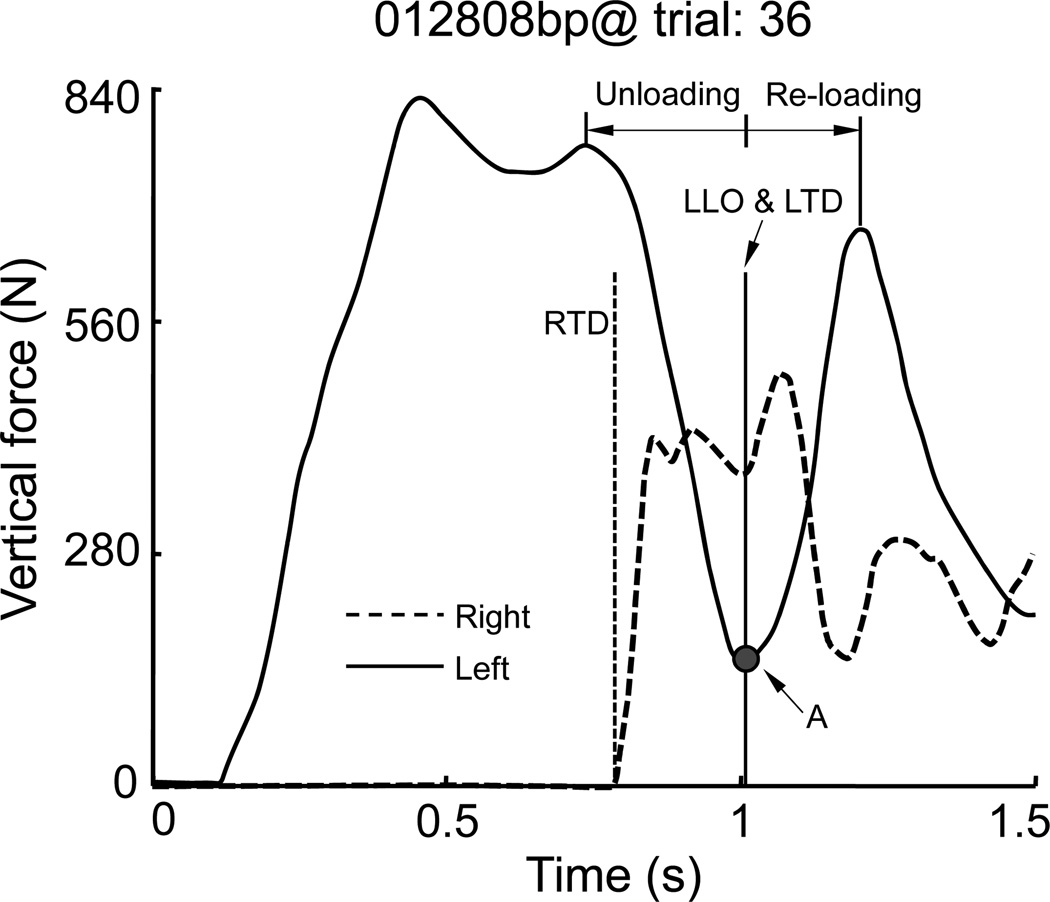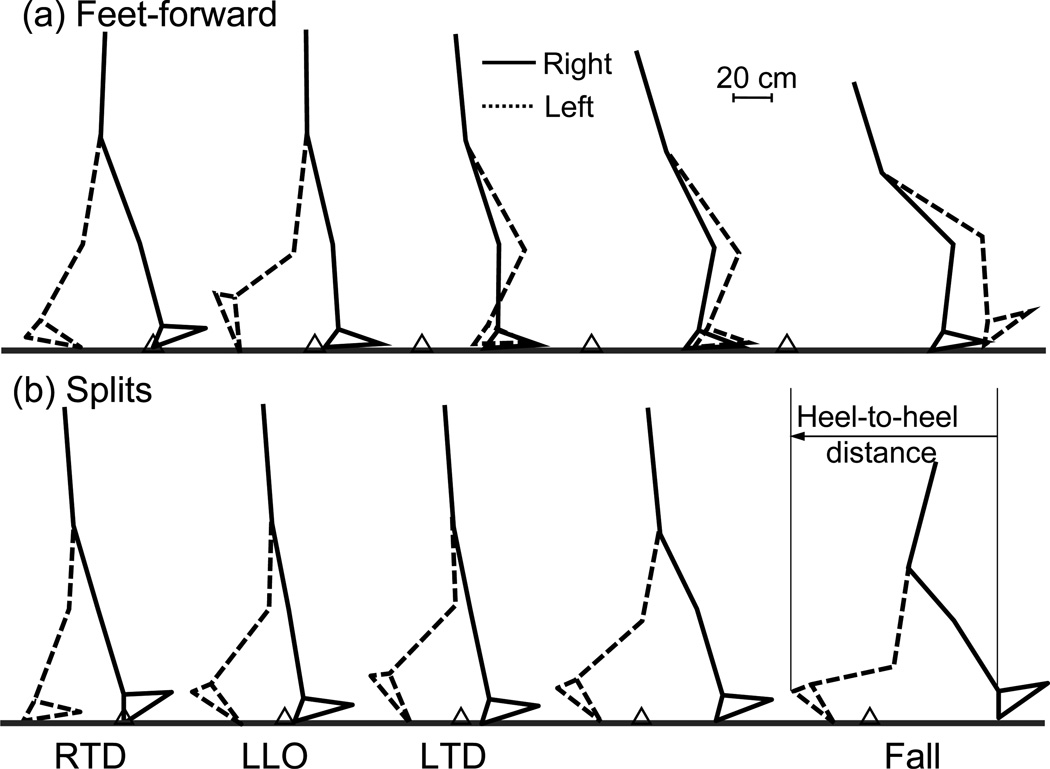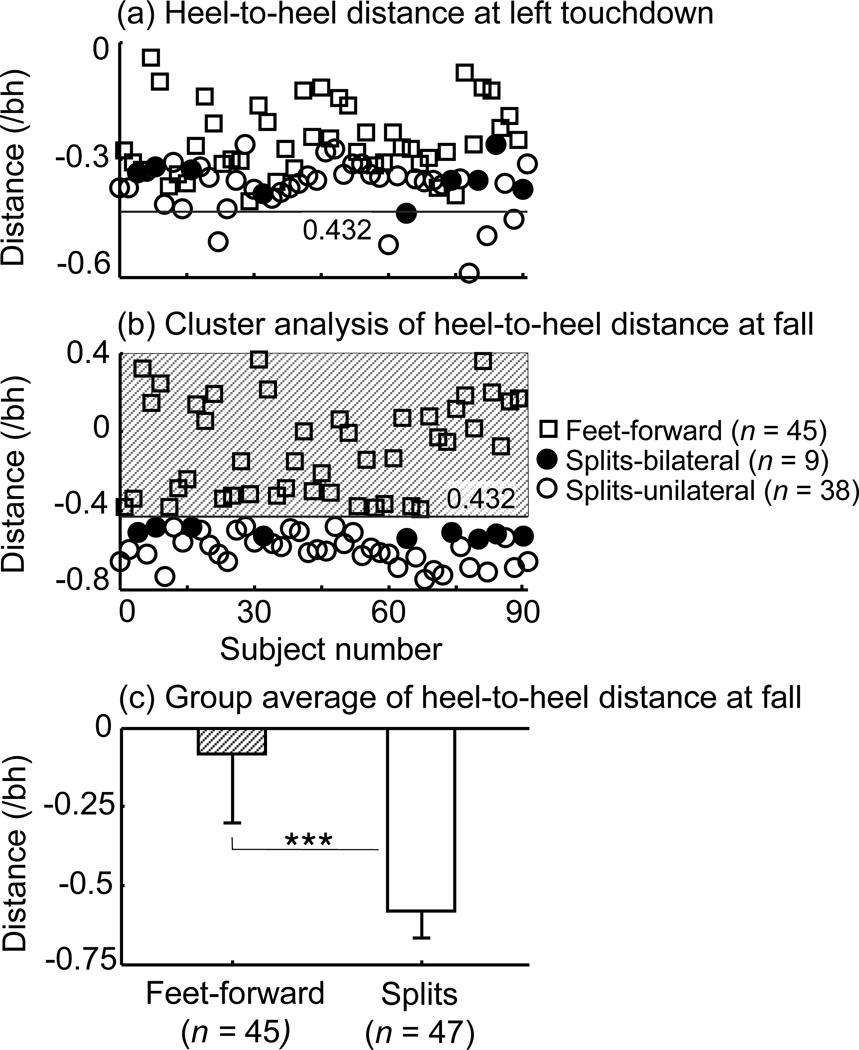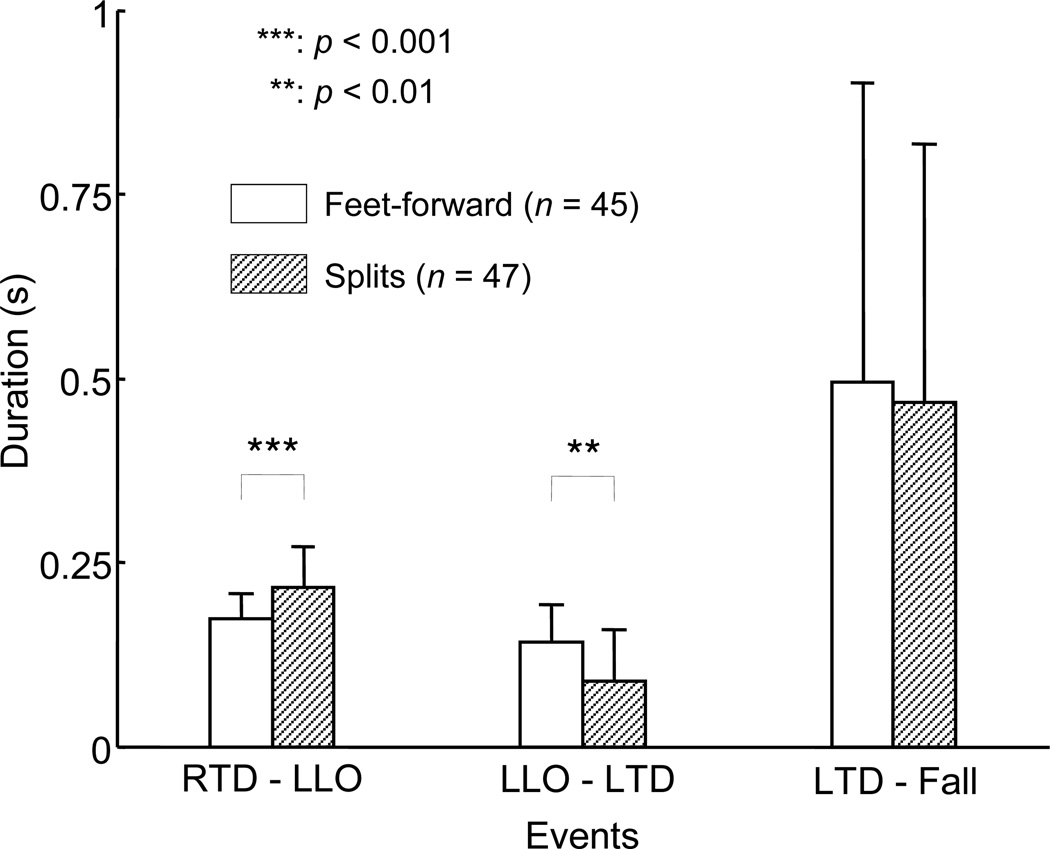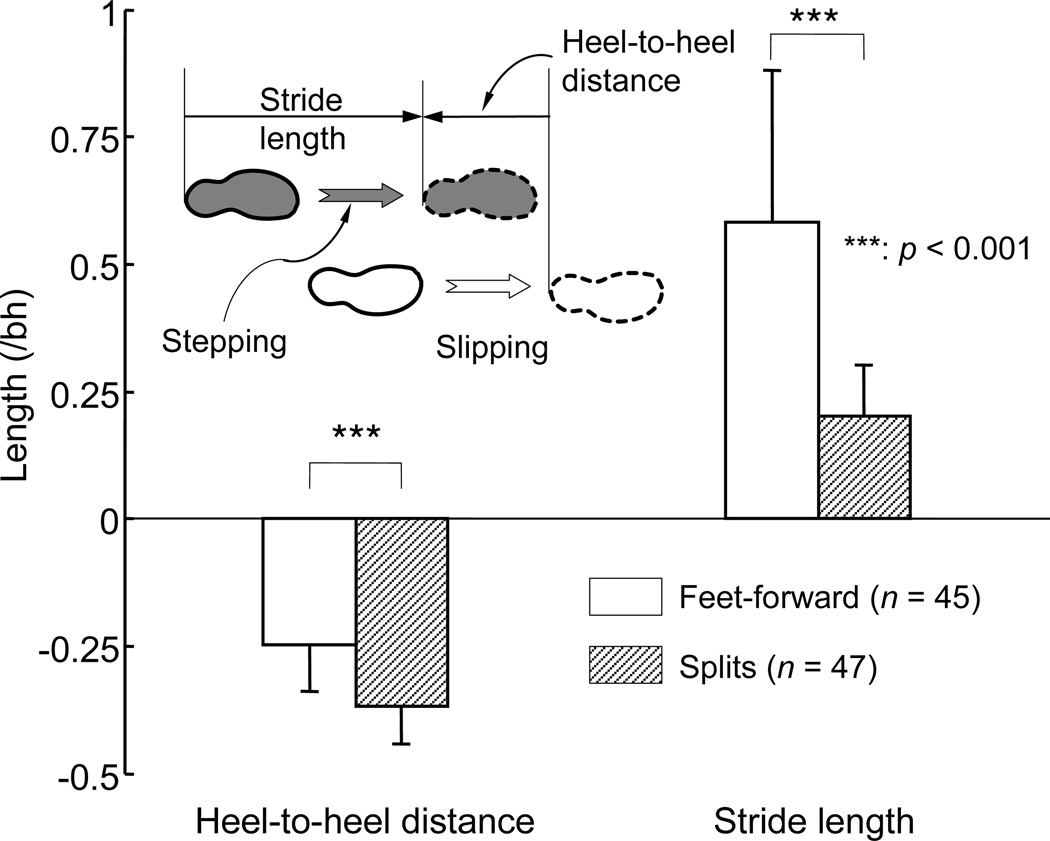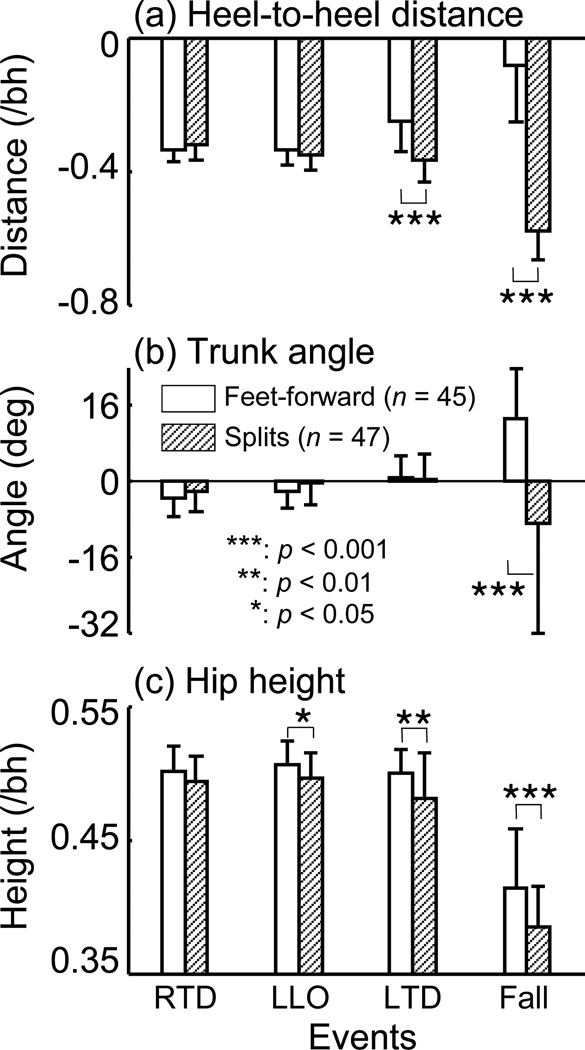Abstract
Little is known about the landing behavior of the trailing (recovery) foot and ensuing types of falls following a forward slip in walking. The purposes of this study were to 1) determine if community-dwelling older adults experienced bilateral slips at the same rate as had been previously observed for young adults during over-ground walking; 2) determine if fall rate in older adults was dependent on slip type (unilateral vs. bilateral); and 3) identify differences in spatiotemporal variables of the trailing leg step between unilateral and bilateral slips. One-hundred-seventy-four participants experienced an unannounced, unrehearsed slip while walking on a 7-m walkway. Each trial was monitored with a motion capture system and bilateral ground reaction force plates. Although the experimental design, developed with original data from a young adult population, favored bilateral slips, more older adults (35%) than anticipated (10% previously observed in young, p<0.001) displayed a unilateral slip. The probability of fall was equal in the two types of slips. Eighty-two people recovered from the slip, while the remaining 92 (53%) fell. These 92 were classified into two exclusive categories based on the heel distance at the time of fall arrest using cluster analysis: those which resembled a fall into a "splits" position (n=47) or a feet-forward fall (n=45). All (100%) unilateral slips led to splits falls, as expected. Yet, not all bilateral slips (only 83%) resulted in feet-forward falls. A longer forward recovery step with a prolonged step time led to both feet slipping, nearly together, hence a feet-forward fall.
Keywords: splits, feet-forward, trailing-foot, hip fracture, forensics
INTRODUCTION
Slip-related falls among older adults often lead to self-imposed limitations on independence of daily activities (Zijlstra et al., 2007). Consequent hip fractures from a fall are only one example of serious injury associated with severe complications and levels of mortality in elderly (Englander et al., 1996). The response of the trailing (recovery) limb to an unexpected slip during walking can directly affect the outcome (i.e., fall or not), while most studies have focused on the leading (slipping) limb (Bhatt et al., 2006; Cham and Redfern, 2001; Ferber et al., 2002; Pai and Bhatt, 2007; Tang and Woollacott, 1998). Several have examined the response in the trailing limb, and found two major strategies for the recovery step: either a brief weight unloading of the trailing limb which may result in an “aborted” step, or a rapid lowering of the trailing limb to re-establish bilateral support (Bhatt et al., 2006; Marigold et al., 2003; Moyer et al., 2009). None addressed the issue of bilateral (vs. unilateral) slip, nor its consequences.
Because of the variability associated with the trailing limb behavior, slip-induced falls may take different forms. Logically, when one takes a longer step during recovery of stability after slip onset, the recovery limb is more likely to experience a slip as well, resulting in a bilateral slip. In this case, the feet must both be traveling forward, and therefore should remain close together in a feet-forward fall. Conversely, a shorter recovery step would more likely lead to the trailing foot landing behind (posterior to) the slippery surface area. It is reasonable to assume that a unilateral slip could cause splits of the leading and trailing feet, hence splits falls, in which the feet remain wide apart, one forward and one behind the torso. Differences in slip-feet kinematics that may lead to different types of falls, may also relate to personal characteristics such as age and gender (O'Neill et al., 1994), gait characteristics (Smeesters et al., 2007), an individual’s trunk orientation (Cavagna et al., 1963; Espy et al., 2010b) or hip height at the time of fall (Yang et al., 2009).
Unfortunately, little is known to verify these postulations. Nonetheless, this is a non-trivial question because not all falls are equally dangerous to individuals. For example, posterolateral or feet-forward falls can carry a higher risk of hip fracture than splits falls because the impact forces at the greater trochanter can be greater and the fallers tend to strike directly onto the trochanter in these types of falls (Nankaku et al., 2005; Smeesters et al., 2007). Feet-forward falls may also have a high risk of wrist fracture due to impact velocity on the outstretched hand (Tan et al., 2006). With age, gait speed becomes slower and step lengths shorter (Laufer, 2005). It is unclear whether these changes would alter the recovery foot placement and affect the slip type and ensuing fall among older adults. Understanding the causation can be fundamental to preventing these dangerous falls or to forensic biomechanics to help decide the liability of the involved parties.
The purposes of this study were to 1) determine if community-dwelling older adults experienced bilateral slips at the same rate as had been previously observed for young adults during over-ground walking; 2) determine if fall rate in older adults was dependent on slip type (unilateral vs. bilateral); and 3) identify differences in spatiotemporal variables of the trailing leg step between unilateral and bilateral slips. We hypothesized that subjects who experienced bilateral slips would have feet-forward falls; thus, all subjects were exposed to the same experimental setup, designed to favor a bilateral slip. Because of the apparently unpredictable nature of the trailing limb behavior, we expected that there might still be unilateral slips, which, we hypothesized alternatively, should result in splits falls
METHODS
Subjects
Three-hundred-fifty-four community dwelling older adults were recruited and screened for exclusionary factors. In the end, 205 paid subjects who gave informed consent participated in the full experiment approved by Institutional Review Board, but only 174 people [120 women; mean (SD) age: 72.4 (5.3) years (range: 65–90)] had a complete data set for further analysis (see below).
Experimental set-up
The details of the experiments were provided in the online supplement. Briefly, unexpected slip perturbations in gait were induced by a sliding device. The device consisted of two low-friction, movable platforms each mounted upon a frame supported by two force plates (AMTI, MA) for recording the ground reaction force (GRF) (Yang and Pai, 2007). A harness connected with a load cell was employed to protect the subjects and to record the amount of its assistance.
After about 10 normal walking trials, the right platform was automatically released by a powered solenoid when the vertical force exerted on it by right (slipping) foot contact exceeded a preset threshold. Subsequently, the left platform was automatically released only if it was contacted by the left (recovery) foot. Because of the pressing need to understand the potentially severe danger of feet-forward falls, the two platforms were offset to preferentially induce bilateral slips by capturing as high as 90% (5%–95% distribution) of the recovery foot landing. Therefore, we expected that 157 subjects (=174×0.9) would experience a bilateral slip. The 8.5-cm left offset posterior to the right platform was determined based on the recovery foot placement from a young adult population (Bhatt et al., 2006).
Data collection and processing
Full body kinematics from 28 retro-reflective markers placed on the subject’s body (26) and platforms (2) were gathered using a motion capture system (MAC, CA) (Refer to online supplement for details). The marker paths were low-pass filtered at marker specific cut-off frequencies ranging from 4.5 to 9Hz using fourth-order, zero-lag, Butter-worth filters (Winter, 2005). Both the load cell signal and GRF were recorded synchronously with the motion system at 600 Hz and were low-pass filtered at 27Hz using fourth-order, zero-lag Butter-worth filters.
Outcomes and events
Fall and recovery were two outcomes of the slip. A fall was identified if the peak load cell force during slip exceeded 30% body weight (bw) (Yang and Pai, 2011). A recovery was identified if the moving average load cell force did not exceed 4.5%bw over any 1-second period after slip onset. Besides 20 trials with missing data or technical error, 11 trials in which the subject’s recovery was assisted by the harness (with load cell force level between those who fell and who recovered) were also excluded. Only falls were analyzed in the remaining sections. All falls were associated with an aborted step, single step or multiple step touchdowns before the time of fall arrest by the harness (the instant when the load cell force reached 30%bw).
The maximum slip velocity was computed for each slip trial. The events of interest included right foot touchdown (RTD), left foot liftoff (LLO), its touchdown (LTD), and the instant of fall arrest. The first three events were determined from the vertical GRF. A vertical force greater than 10N corresponds to touchdown of that foot; descent below 10N corresponds to liftoff (Ghoussayni et al., 2004). For an aborted step, LLO and LTD were the same and taken as the instant at which the vertical GRF under the left foot reached its minimum during the unloading/reloading period (Espy et al., 2010a) (Fig. 1). For multiple-step fallers, only the first recovery step was examined for standardization. Hip height was the vertical distance from the hips to the ground. Trunk angle was calculated between the trunk segment and a vertical axis. The recovery stride length was the travel distance of the contra-lateral (left) heel from LLO to LTD in the anteroposterior (AP) direction. The “post-slip” step length, or the heel-to-heel distance (dheel) at the landing of the recovery step was measured as the AP distance between the two heels. In the case of backward balance loss in which the recovery foot lands posteriorly, a longer recovery step (with longer stride length) leads to landing the recovery foot less-posterior (closer) to the slipping foot thus results in a shorter heel-to-heel distance.
Fig. 1.
Typical profile of vertical ground reaction forces (GRF) for subjects who aborted their recovery (left) step after the slip onset, which is approximately 30ms after right (slipping) foot touchdown (RTD) on the platform. The recovery foot did not completely take off from the ground to accomplish the recovery the step. Correspondingly, the vertical GRF under the left foot after slip onset first decreased (unloading phase) and then increased (re-loading phase) before it became zero. The instant of the minimum vertical GRF (point A) under the left foot was identified as recovery foot liftoff (LLO) and touchdown (LTD).
Statistical analysis
χ2 test was used to examine the difference between observed and expected bilateral slip incidence, the likelihood of falls in uni- vs. bilateral slips, and the likelihood of different fall types between genders. The absolute values of dheel at fall arrest for all falls were entered into a cluster analysis. The analysis automatically classified these into two clusters corresponding to a feet-forward fall and a splits fall. Logistic regression with the cutoff probability of 0.5 was then used to determine the value which best categorized these two fall types. Thus the demographic parameters, recovery stride length, dheel, hip height, and trunk angle at RTD, LLO, LTD and fall arrest, and durations from RTD to LLO, from LLO to LTD, and from LTD to fall arrest, were compared between fall groups in post-hoc analyses using independent t-tests. All statistics were performed using SPSS 17.0 (Chicago, IL); a significance level of 0.05 was used.
RESULTS
All (174) subjects experienced a backward balance loss in response to the unannounced slip (recovery foot landed posterior to the slipping foot). One-hundred-thirteen (65%) experienced a bilateral slip (Fig. 2a) and the remaining 61 (35%, including 13 with an aborted step) a unilateral slip (Fig. 2b, Table 1). Ninety-two people (53%) fell, from both types of slip (Fig. 3b), each of which had a comparable likelihood of causing falls (p>0.05).
Fig. 2.
Stick-figure animation sequence of a representative (a) feet-forward faller and (b) splits faller in responding to a slip induced in gait. The solid and dashed lines, respectively, indicate the right and left sides. The triangle is the starting position of the right heel at right foot touchdown. The five frames on each panel respectively correspond with the instants of the right foot touchdown (RTD), left liftoff (LLO), left touchdown (LTD), the middle frame between LTD and fall, and the instant of fall. Also shown is the definition of the heel-to-heel distance at fall instant.
Table 1.
Distribution of the platform number triggered during the gait slip test for both feet-forward and splits fall groups.
| Falls | Recoveries | Total | ||
|---|---|---|---|---|
| Feet-forward | Splits | |||
| Bilateral slip | 45 a | 9 b | 59 | 113 |
| Unilateral slip | 0 | 38 c | 23 | 61 |
| Total | 45 | 47 | 82 | 174 |
including 34 single-step falls and 11 multiple-step falls;
including 9 single-step falls;
including 13 aborted-step falls, 24 single-step falls, and 1 two-step fall. The number of recovery steps was determined as the number of steps following the slip onset but before fall arrest.
Fig. 3.
(a) The distribution of the left heel landing location relative to the right heel (0) for all fallers at left touchdown. (b) The distribution of the relative heel landing location at fall arrest for all fallers. Each symbol represents a subject. Cluster analysis successfully classified these distances into two clusters, as feet-forward (squares) and splits (circles) falls. The thin horizontal line indicates the threshold value of the recovery step length categorizing the fall type. On (a) and (b), open circles indicate the splits falls with unilateral slip while shaded circle represents splits fallers with bilateral slip. (c) The comparison of the heel distance at fall between the feet-forward falls and splits falls. The heel distance is normalized to body height (bh).
Cluster analysis was able to identify unambiguously two types of falls by the time of fall arrest (Fig. 3b). The absolute dheel of all splits falls (n=47) were greater than 0.43 body height (bh). Those below this value were feet-forward falls (n=45), which had a significantly shorter dheel than the splits group at fall arrest (Fig. 3c, p<0.001). Among the feet-forward falls, 11 (24%) fell after taking multiple recovery steps and the remaining 76% were single-step falls (Table 1). Among the splits fallers, 13 (28%) aborted the recovery step after slip onset and one (2%) fell after 2 recovery steps. The remaining 33 (70%) were single-step falls (Table 1). Among these falls all (100%) of the 38 unilateral slips (including 13 aborted step) resulted in splits falls, while only 45 (83%) of the 54 bilateral slips led to feet-forward falls (Table 1).
The maximum slip velocity was significantly higher during bilateral than unilateral slip (2.51±0.46 vs. 2.23±0.41m/s, p<0.01). Post-hoc analyses did not reveal any significant body height or gender effects on fall types (Table 2). The group with feet-forward falls was younger (p<0.05) and weighed less (p<0.001) than the group with splits falls (Table 2). Less time elapsed from RTD to LLO in feet-forward falls than in splits falls (172.8±35.2 vs. 217.5±54.3ms, p<0.001, Fig. 4). However, the duration of the phase from LLO to LTD was longer in the feet-forward falls in comparison to the splits falls (p<0.01, Fig. 4). The time from LTD to fall arrest did not differ between groups (p>0.05, Fig. 4). The feet-forward fallers took a longer recovery step (p<0.001), which caused a less-posterior landing, closer (p<0.001) to the slipping foot, than did the splits fallers (Fig. 5). However, no between-group difference was found in the step length or hip height at RTD during regular gait (Fig. 6a & c). Hip height was lower in the splits falls than in the feet-forward falls from LLO (p<0.05) to fall arrest (p<0.001, Fig. 6c). There were no differences in trunk angle at RTD, LLO or LTD, but at fall arrest feet-forward fallers extended their trunk more than splits fallers (p<0.001, Fig. 6b).
Table 2.
Comparisons of the demographics in means (SD) between feet-forward and splits fall groups.
| Group | Feet-forward (n = 45) | Splits (n = 47) | p value |
|---|---|---|---|
| Age (years) | 71.3 (4.8) | 73.7 (6.2) | 0.041 |
| Gender (female) | 32 | 40 | 0.104* |
| Body mass (kg) | 70.6 (11.8) | 80.2 (14.1) | 0.001 |
| Body height (m) | 1.65 (0.09) | 1.64 (0.07) | 0.335 |
| Foot length (cm) | 28.3 (2.4) | 27.5 (2.0) | 0.141 |
the χ2 test was used.
Fig. 4.
Group means (column height) and standard deviations (bar) of the elapsed time between events in seconds for feet-forward and splits falls. The events include right foot touchdown (RTD), left foot liftoff (LLO), left foot touchdown (LTD), and the instant of fall.
Fig. 5.
The comparison of the heel-to-heel distance at left (recovery) foot touchdown (LTD), and the recovery stride length from left liftoff (LLO) to LTD between the feet-forward fall and splits fall groups. All lengths are normalized to body height (bh). Also shown are the definitions of heel-to-heel distance at LTD, and recovery stride length of the recovery limb (shaded) from LLO to LTD. The feet are indicated by solid and dashed lines respectively at LLO and LTD.
Fig. 6.
Comparison of (a) the heel-to-heel distance, (b) the trunk angle, and (c) the hip height at different events between feet-forward and splits fall groups. The events include right foot touchdown (RTD), left foot liftoff (LLO), left foot touchdown (LTD), and the instant of fall. Both heel-to-heel distance and hip height are normalized to body height (bh). Positive trunk angle represents that the trunk leans backward against the vertical line.
DISCUSSION
Although all subjects faced the same experimental conditions, favoring a bilateral over a unilateral slip, more than expected actually displayed a unilateral slip. Yet, slip type did not affect the likelihood of a fall. While unilateral slips resulted in splits falls, bilateral slips did not, as hypothesized, exclusively lead to feet-forward falls. With a brief initiation time, a prolonged step time resulted in a longer recovery step length, landing it posterior to but nearer the slipping foot in feet-forward falls.
The design of the slip-inducing apparatus was expected to capture most (90%) older adults’ recovery (left) foot touchdowns on the left platform in a bilateral slip. However, our results revealed that35% of older adults, much more than anticipated (10% previously observed in young, p<0.001) took a short recovery step and hence landed either completely or partially outside of the left platform. Age-related reductions in step length and regular gait speed might partially contribute to this difference.
The present study was the first to reveal a comparable likelihood of a fall associated with each type of slip. As expected, for most of the subjects who landed their left foot on the left platform and who experienced a bilateral slip (~83%), both feet always moved ahead of the center of mass (COM) in the “feet forward” fall, resulting in the COM “falling backward” relative to the feet. Although the trailing foot of the remaining 17% of bilateral slips did indeed travel forward rather than backward after landing on the platform, these people were able to slow down its slipping, hence reducing its slip distance. This resulted in the feet growing progressively further apart throughout the slip recovery attempt while the trunk began to descend between the two feet. A post-hoc analysis also revealed that the initial landing of the trailing foot of this subset of bilateral slips was more posterior to the body COM than those in feet-forward falls (0.22 vs. 0.16bh, p<0.05) with a comparable regular gait speed (1.04 vs. 1.08m/s, p>0.05). During this bipedal stance after LTD, a more posterior left foot relative to the COM provides greater stability to the person during a bilateral slip. Thus, this should be a more desirable recovery strategy.
It has been proposed that an aborted or very quickly terminated recovery step may be a consequence of a severe slip rather than a strategy (Moyer et al., 2009). This would argue that the unilateral slip could have more severe slips than the bilateral slip group as the intensity of a slip is often measured by the maximum velocity of a slip (Moyer et al., 2009). However, the present study failed to support this notion. In fact, unilateral slips had a slower slip velocity (2.23±0.41m/s) than bilateral slips (2.51±0.46m/s, p<0.01), whereby those with aborted steps were the slowest (1.95±0.32 m/s, p<0.001).
In the (presumably safer) splits falls, the longer preparation time (double stance phase time, Fig 4) to initiate the recovery step may enable the central nervous system to substantially modulate the pattern generators’ functions by drastically shortening the step (or aborting that step altogether). Alternatively, it may be indicative of a slower response consistent with this group also being significantly older (by about 2.5 years). Although a shorter or aborted step would be more desirable for stability recovery, there is a limit to how much a motor program can be modified, irrespective of age, it takes longer to more substantially modify the ongoing motor program (Yang et al., 2009). Further, one’s regular gait pattern can dictate the trailing limb behavior, specifically, pre-perturbation gait speed and step length can influence the recovery step (Espy et al., 2010a). Faster gait speeds often lead to longer recovery steps (and longer stride lengths) (Bhatt et al., 2005), in part because less time is available to modify the ongoing motor program. Thus, faster gait speeds might be more likely to result in feet-forward rather than splits falls.
Although this study was centered on spontaneous walking, with preferred rather than prescribed speeds, our post-hoc analysis confirmed that feet-forward fallers walked significantly faster (1.08 vs. 0.86m/s, p<0.001) than the splits fall group. On the other hand, the stride length of their regular gait might play a less prominent role here as dheel showed no difference between groups at RTD or LLO (p>0.05, Fig. 6a). Because the splits group landed their left (recovery) foot sooner with a shorter recovery step (i.e., a more posterior landing resulting in a shorter stride length), dheel in splits falls was, without exception, longer than in the feet-forward group at LTD (0.77 vs. 0.21 bh, p<0.001). This difference grew so significantly later that it became the discriminating variable for fall type at fall arrest (Fig. 3). Nevertheless, to determine the relationship between gait pattern (i.e., gait speed and step length) and types of falls would require the direct control of each gait parameter (Espy et al., 2010b).
In addition to gait speed and step length, the angle of the trunk has been shown to influence maintenance of stability throughout a slip (Espy et al., 2010a). The present results revealed that the trunk control was remarkably tight, nearly vertical, and consistent in all subjects throughout the recovery until the time of fall arrest (Fig. 6b). At fall arrest, those who fell with their feet forward extended their trunk, resulting in the COM falling backward and behind the forward slipping feet. Those who had a splits fall flexed their trunk later: at fall arrest they leaned their weight forward in a more stable and perhaps safer strategy. Prior to slip initiation, hip height did not differ between the two groups. After LLO, hip height for the splits group began descending; whereas for the feet-forward group, hip height continued to rise for a short period (~50ms) following LLO then began descending. This difference in hip height remained to fall arrest.
Posterolateral falls carry a higher risk of hip fracture than other types because of the high likelihood of direct strikes onto the greater trochanter (Nankaku et al., 2005; Smeesters et al., 2007). Until now, little connection had been made between the trailing limb landing, the subsequent bi- vs. unilateral slips, and the ensuing types of falls and impact region. It did appear that the feet-forward falls described here would expose the hip region directly to the ground impact and thus leave them vulnerable to high-speed impact and fracture. In comparison, splits falls might be less dangerous as the trailing limb remains further behind. Not only could it reduce the speed of descent, but also physically damp direct contact between the hip region and the ground. Clearly, not all falls are equal in terms of the danger of potential harm.
The current findings could have several implications to a better understanding of falls. For instance, mathematical simulation is necessary for a more comprehensive understanding of the biomechanics of walking and slip-induced falls. In concert with other contemporary research (Lo and Ashton-Miller, 2008; Robinovitch et al., 2000; Smeesters et al., 2007), the characteristics of each type of fall identified here provide realistic and accurate input to appropriate human simulation models of the final phases of a fall. The kinematic data obtained (hip position and velocity), could guide the determination of essential simulation parameters. In addition, the findings can guide development of hypotheses for future studies. Slower gait that is more likely to lead a person to a less dangerous form of falls could mitigate the downside of this age related alteration as a commonly recognized fall risk factor among older adults (Kelsey et al., 2005). Finally, it might not be farfetched to say that the present study provides detailed and potentially useful information for forensic biomechanics on the facts about slip-recovery behavior. It may also be useful for product development, such as wearable sensors (Nyan et al., 2008) that can effectively and efficiently be deployed to trigger an air-bag-like device to reduce damage from the impact of a fall (Shi et al., 2009), hip protectors (Kannus et al., 2000), or safe floors (Casalena et al., 1998).
In summary, this study is the first attempt to develop a threshold that classifies fall types with uni- or bilateral slips and to reveal their relationship with ensuing falls. The findings of this study indicated that both types of slip have a comparable likelihood of falls and a bilateral slip more likely leads to a feet-forward fall while a unilateral slip almost exclusively results in a splits fall.
Supplementary Material
Acknowledgements
This work was funded by NIH 2RO1-AG16727 and RO1-AG029616. The authors thank Ting-Yun Wang and Ying-Chen Chen for assisting in data collection.
Footnotes
Publisher's Disclaimer: This is a PDF file of an unedited manuscript that has been accepted for publication. As a service to our customers we are providing this early version of the manuscript. The manuscript will undergo copyediting, typesetting, and review of the resulting proof before it is published in its final citable form. Please note that during the production process errors may be discovered which could affect the content, and all legal disclaimers that apply to the journal pertain.
Conflict of Interest Statement
None declared.
References
- Bhatt T, Pai Y-C. Long-term retention of gait stability improvements. Journal of Neurophysiology. 2005;94:1971–1979. doi: 10.1152/jn.00266.2005. [DOI] [PubMed] [Google Scholar]
- Bhatt T, Wening JD, Pai Y-C. Influence of gait speed on stability: recovery from anterior slips and compensatory stepping. Gait and Posture. 2005;21:146–156. doi: 10.1016/j.gaitpost.2004.01.008. [DOI] [PubMed] [Google Scholar]
- Bhatt T, Wening JD, Pai Y-C. Adaptive control of gait stability in reducing slip-related backward loss of balance. Experimental Brain Research. 2006;170:61–73. doi: 10.1007/s00221-005-0189-5. [DOI] [PubMed] [Google Scholar]
- Casalena JA, Ovaert TC, Cavanagh PR, Streit DA. The Penn state safety floor: part II - Reduction of fall-related peak impact forces on the femur. Journal of Biomechanical Engineering. 1998;120:527–532. doi: 10.1115/1.2798023. [DOI] [PubMed] [Google Scholar]
- Cavagna GA, Saibene FP, Santi GF, Margaria R. Analysis of the mechanics of locomotion. Experimental Medicine and Surgery. 1963;21:117–126. [PubMed] [Google Scholar]
- Cham R, Redfern MS. Lower extremity corrective reactions to slip events. Journal of Biomechanics. 2001;34:1439–1445. doi: 10.1016/s0021-9290(01)00116-6. [DOI] [PubMed] [Google Scholar]
- Englander F, Hodson TJ, Terregrossa RA. Economic dimensions of slip and fall injuries. Journal of Forensic Sciences. 1996;41:733–746. [PubMed] [Google Scholar]
- Espy DD, Yang F, Bhatt T, Pai Y-C. Independent influence of gait speed and step length on stability and fall risk. Gait and Posture. 2010a;32:378–382. doi: 10.1016/j.gaitpost.2010.06.013. [DOI] [PMC free article] [PubMed] [Google Scholar]
- Espy DD, Yang F, Pai Y-C. Control of center of mass motion state through cuing and decoupling of spontaneous gait parameters in level walking. Journal of Biomechanics. 2010b;43:2548–2553. doi: 10.1016/j.jbiomech.2010.05.015. [DOI] [PMC free article] [PubMed] [Google Scholar]
- Ferber R, Osternig LR, Woollacott MH, Wasielewski NJ, Lee J-H. Reactive balance adjustments to unexpected perturbations during human walking. Gait and Posture. 2002;16:238–248. doi: 10.1016/s0966-6362(02)00010-3. [DOI] [PubMed] [Google Scholar]
- Ghoussayni S, Stevens C, Durham S, Ewins D. Assessment and validation of a simple automated method for the detection of gait events and intervals. Gait and Posture. 2004;20:266–272. doi: 10.1016/j.gaitpost.2003.10.001. [DOI] [PubMed] [Google Scholar]
- Kannus P, Parkkari J, Niemi S, Pasanen M, Palvanen M, Jarvinen M, Vuori I. Prevention of hip fracture in elderly people with use of a hip protector. The New England Journal of Medicine. 2000;343:1506–1513. doi: 10.1056/NEJM200011233432101. [DOI] [PubMed] [Google Scholar]
- Kelsey JL, Prill MM, Keegan THM, Tanner HE, Bernstein AL, Quesenberry CP, Sidney S. Reducing the risk for distal forearm fracture: preserve bone mass, slow down, and don't fall. Osteoporosis International. 2005;16:681–690. doi: 10.1007/s00198-004-1745-8. [DOI] [PubMed] [Google Scholar]
- Laufer Y. Effect of age on characteristics of forward and backward gait at preferred and accelerated walking speed. Journal of Gerontology Series A: Biological Sciences and Medical Sciences. 2005;60:627–632. doi: 10.1093/gerona/60.5.627. [DOI] [PubMed] [Google Scholar]
- Lo J, Ashton-Miller JA. Effect of pre-impact movement strategies on the impact forces resulting from a lateral fall. Journal of Biomechanics. 2008;41:1969–1977. doi: 10.1016/j.jbiomech.2008.03.022. [DOI] [PMC free article] [PubMed] [Google Scholar]
- Marigold DS, Bethune AJ, Patla AE. Role of the unperturbed limb and arms in the reactive recovery response to an unexpected slip during locomotion. Journal of Neurophysiology. 2003;89:1727–1737. doi: 10.1152/jn.00683.2002. [DOI] [PubMed] [Google Scholar]
- Moyer BE, Redfern MS, Cham R. Biomechanics of trailing let response to slipping - Evidence of interlimb and intralimb coordination. Gait and Posture. 2009;29:565–570. doi: 10.1016/j.gaitpost.2008.12.012. [DOI] [PMC free article] [PubMed] [Google Scholar]
- Nankaku M, Kanzaki H, Tsuboyama T, Nakamura T. Evaluation of hip fracture risk in relation to fall direction. Osteoporosis International. 2005;16:1315–1320. doi: 10.1007/s00198-005-1843-2. [DOI] [PubMed] [Google Scholar]
- Nyan MN, Tay FEH, Murugasu E. A wearable system from pre-impact fall detection. Journal of Biomechanics. 2008;41:3475–3481. doi: 10.1016/j.jbiomech.2008.08.009. [DOI] [PubMed] [Google Scholar]
- O'Neill TW, Varlow J, Silman AJ, Reeve J, Reid DM, Todd C, Woolf AD. Age and sex influences on fall characteristics. Annals of the Rheumatic Diseases. 1994;53:773–775. doi: 10.1136/ard.53.11.773. [DOI] [PMC free article] [PubMed] [Google Scholar]
- Pai Y-C, Bhatt T. Repeated slip training: An emerging paradigm for prevention of slip-related falls in older adults. Physical Therapy. 2007;87:1478–1491. doi: 10.2522/ptj.20060326. [DOI] [PMC free article] [PubMed] [Google Scholar]
- Robinovitch SN, Chiu J, Sandler R, Liu Q. Impact severity in self-initiated sits and falls associates with center-of-gravity excursion during descent. Journal of Biomechanics. 2000;33:863–870. doi: 10.1016/s0021-9290(00)00025-7. [DOI] [PubMed] [Google Scholar]
- Shi GY, Chan CS, Li WJ, Leung KS, Zou YX, Jin YF. Mobile human airbag system for fall protection using MEMS sensors and embedded SVM classifier. IEEE Sensors Journal. 2009;9:495–502. [Google Scholar]
- Smeesters C, Hayes WC, McMahon TA. Determining fall direction and impact location for various disturbances and gait speeds using the articulated total body model. Journal of Biomechanical Engineering. 2007;129:393–399. doi: 10.1115/1.2737432. [DOI] [PubMed] [Google Scholar]
- Tan JS, Eng JJ, Robinovitch SN, Warnick B. Wrist impact velocities are smaller in forward falls than backward falls from standing. Journal of Biomechanics. 2006;39:1804–1811. doi: 10.1016/j.jbiomech.2005.05.016. [DOI] [PubMed] [Google Scholar]
- Tang PF, Woollacott MH. Inefficient postural responses to unexpected slips during walking in older adults. Journal of Gerontology Series A: Biological Sciences and Medical Sciences. 1998;53:M471–M480. doi: 10.1093/gerona/53a.6.m471. [DOI] [PubMed] [Google Scholar]
- Winter DA. Biomechanics and Motor Control of Human Movement. Hoboken, NJ: Wiley; 2005. [Google Scholar]
- Yang F, Bhatt T, Pai Y-C. Role of stability and limb support in recovery against a fall following a novel slip induced in different daily activities. Journal of Biomechanics. 2009;42:1903–1908. doi: 10.1016/j.jbiomech.2009.05.009. [DOI] [PMC free article] [PubMed] [Google Scholar]
- Yang F, Pai Y-C. Correction of the inertial effect resulting from a plate moving under low-friction conditions. Journal of Biomechanics. 2007;40:2723–2730. doi: 10.1016/j.jbiomech.2006.12.008. [DOI] [PMC free article] [PubMed] [Google Scholar]
- Yang F, Pai Y-C. Automatic recognition of falls in gait-slip training: Harness load cell based criteria. Journal of Biomechanics. 2011;44:2243–2249. doi: 10.1016/j.jbiomech.2011.05.039. [DOI] [PMC free article] [PubMed] [Google Scholar]
- Zijlstra GA, van Haastregt JC, van Rossum E, van Eijk JT, Yardley L, Kempen GI. Interventions to reduce fear of falling in community-living older people: a systematic review. Journal of the American Geriatrics Society. 2007;55:603–615. doi: 10.1111/j.1532-5415.2007.01148.x. [DOI] [PubMed] [Google Scholar]
Associated Data
This section collects any data citations, data availability statements, or supplementary materials included in this article.



